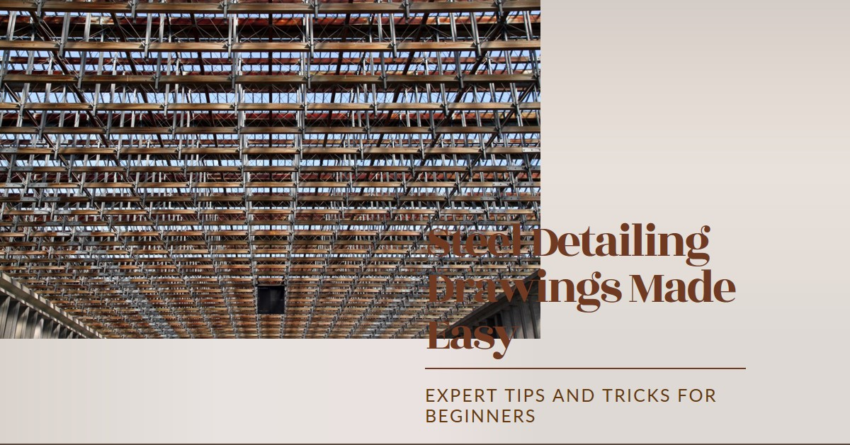In the realm of structural engineering, precision is paramount. Steel detailing drawings serve as the backbone of any construction project, providing a meticulous roadmap for builders and fabricators. This comprehensive guide will navigate you through the intricate art of steel detailing drawings, exploring their significance, benefits, and the advanced techniques employed in their creation.
The Foundation: Understanding Steel Detailing Drawings
Before delving into the nuances of steel detailing drawings, it’s crucial to comprehend their fundamental role in the construction process. These drawings are meticulous plans that showcase the specifics of a steel structure, acting as a visual guide for the fabrication and erection of steel components. They encompass a wide array of details, ranging from dimensions and material specifications to welding symbols and connection details.
Benefits of Steel Detailing Drawings
Precision Redefined
Steel detailing drawings are the epitome of precision in construction. They leave no room for ambiguity, providing a clear and concise representation of the structure’s geometry and specifications. This level of precision not only ensures accurate fabrication but also minimizes errors during the construction phase.
Cost-Efficiency
The devil is in the details, and in construction, overlooking these details can lead to significant financial setbacks. Steel detailing drawings facilitate accurate material estimation, reducing wastage and preventing costly rework. This meticulous planning contributes to overall cost-efficiency, a crucial aspect in today’s competitive construction industry.
Techniques in Steel Detailing Drawings
3D Modeling: Bringing Designs to Life
Transitioning from traditional 2D drawings to 3D modeling has revolutionized steel detailing. This technique allows for a more immersive understanding of the structure, enabling stakeholders to visualize the end product in a realistic manner. The incorporation of 3D models enhances communication among project teams, reducing misunderstandings and improving overall project efficiency.
Building Information Modeling (BIM)
BIM has emerged as a game-changer in the world of steel detailing drawings. This collaborative approach integrates various aspects of the construction process into a single digital model. BIM not only enhances coordination among different disciplines but also enables real-time collaboration, fostering a more efficient and integrated project delivery.
The Role of Technology
CAD Software: Precision at Your Fingertips
Computer-Aided Design (CAD) software has become the backbone of steel detailing. With its advanced tools and features, CAD software allows for the creation of intricate and accurate drawings. The transition from manual drafting to CAD has significantly expedited the detailing process while maintaining a high level of precision.
Automation for Efficiency
Automation is reshaping the steel detailing landscape. From automating repetitive tasks to generating accurate quantity takeoffs, automation tools streamline the detailing process. This not only reduces the chances of errors but also expedites project timelines, a crucial factor in meeting tight construction schedules.
Evolving Standards and Codes
The field of steel detailing is dynamic, with standards and codes evolving to meet the demands of modern construction. Staying abreast of these changes is imperative for detailing professionals. Adhering to the latest industry standards ensures that the steel detailing drawings not only meet safety requirements but also stand the test of time.
Challenges in Steel Detailing Drawings
Balancing Detail and Clarity
One of the primary challenges in steel detailing is striking the right balance between providing detailed information and maintaining clarity. Overloading drawings with excessive details can lead to confusion, while insufficient information can compromise the precision required for fabrication and construction.
Collaboration and Communication
Effective communication among project stakeholders is a perennial challenge in the construction industry. Steel detailing drawings serve as a common language, but ensuring that all team members interpret them correctly requires robust communication channels. Embracing collaborative tools and fostering open communication can mitigate this challenge.
Future Trends in Steel Detailing
Artificial Intelligence (AI) Integration
The integration of Artificial Intelligence in steel detailing is on the horizon. AI algorithms can analyze vast datasets to optimize structural designs, improve material selection, and enhance the overall efficiency of the detailing process. This technological leap holds the potential to redefine how steel structures are conceptualized and brought to life.
Sustainable Detailing Practices
As sustainability takes center stage in construction, steel detailing is no exception. Future trends in steel detailing will likely see a surge in sustainable practices, from optimizing material usage to designing structures that minimize environmental impact. Adapting to these trends will not only align with global sustainability goals but also position projects for long-term success.
Conclusion
In the intricate world of construction, steel detailing drawings stand as a testament to precision and meticulous planning. From their foundational role in providing detailed guidance to the incorporation of advanced technologies, the art of steel detailing continues to evolve. As we navigate the challenges and embrace future trends, one thing remains constant – the indispensable role of steel detailing in shaping the structures that define our world. So, the next time you marvel at a towering skyscraper or a meticulously designed bridge, remember that behind the scenes, steel detailing drawings have played a pivotal role in bringing these architectural marvels to life.
Also know Unlocking Precision and Efficiency with Precast Detailing Services.

